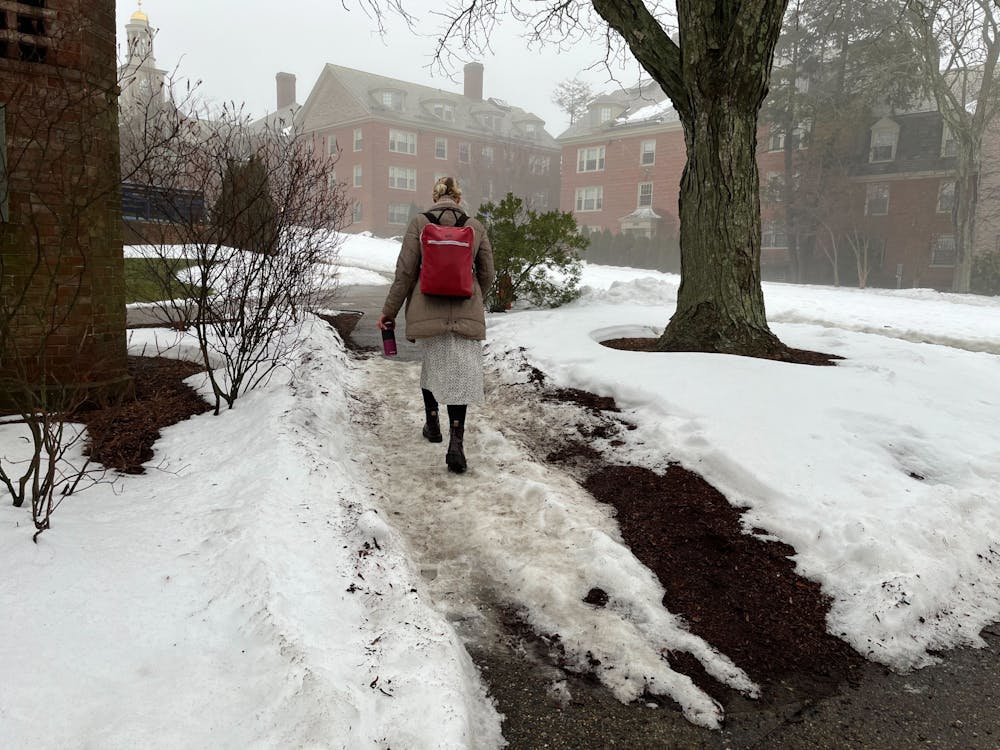In the wake of the Jan. 29 blizzard that brought over 21 inches of snow to Rhode Island, students and professors experienced difficulty navigating campus on icy or blocked paths.
For those with mobility impairments or mobility-related disabilities, the snowstorm merely compounded previous accessibility difficulties on campus. According to Sarah Skeels, senior teaching associate in behavioral and social sciences, such inclement weather events amplify accessibility challenges.
Challenges in snow and ice
Delaney Dill ’24, who has an auto-immune disease, said that movement can be difficult when her condition flares up. Snow and ice “just makes (those moments) a lot more challenging and something that I definitely have to intentionally think about when planning on getting to classes or work and other commitments,” Dill said.
“A minor inconvenience for some might be the barrier that prevents another from accessing places like a dining hall or a classroom or a study space,” she added.
Michael Chandler ’22, who has been in a boot due to an athletic injury, said that when it comes to severe weather, ice proves to be the most challenging terrain to travel.
“The boot is not designed for moving on ice,” Chandler said. “I’m lucky that I’m not on my scooter anymore because I think I’d have even more issues trying to navigate.”
Both Dill and Chandler said that last week, they walked on the roads instead of sidewalks, which tended to be clearer due to plowing.
For wheelchair users, snow height poses an additional challenge.
“It can be very challenging to navigate campus in big snowstorms — curb cuts tend to be places shovelers leave the snow and sidewalks aren't cleared at a width that allows a wheelchair to pass through,” Skeels wrote in an email to the Herald.
In order to navigate campus amidst and after a storm, Skeels tries to find routes ahead of time.
“I first drive around a lot to try and figure out a ‘best route,’” Skeels wrote. “Even after doing that, it can be hard because you can start on a path and end up stuck, then you have to turn around and find another route.”
According to Skeels, the whole process can require significant energy and planning.
“If I can't get into a space, I can call the facilities team who will help me, but I have to wait for all of that to happen, which can take time because those people are hard at work doing other things that need to be done,” Skeels wrote.
University response and action
According to Paul Armas, assistant vice president of Facilities Operations, the Facilities Management grounds crew are the “primary responders to snow removal activities” on and around campus, he wrote in an email to The Herald. The University also supplements the grounds crew with assistance from third party contractors and custodial staff.
In the days before the storm, the University met to prepare and review snow removal plans.
“All members of the FM maintenance trades, custodial, grounds and service response teams are designated as essential personnel and support the campus during snowstorms,” Armas wrote. “We monitor conditions, pre-treat surfaces and adjust priorities as needed.”
Assistant Director of Student Accessibility Services Desirae Mix said that those with mobility concerns may fill out the office’s Priority Snow Removal form to voice navigation needs, which SAS then uses to notify Facilities Management.
Mix said that shoveling and plowing efforts are complicated by property lines, which may prevent Facilities Management from shoveling sidewalks that are used by Brown students but not connected to Brown property.
Students and professors with mobility impairments offered mixed reactions to the University’s storm response.
“Brown’s actually pretty good about (salting sidewalks),” Chandler said. “There tends to be more issues if I’m walking away from campus,”
“While we don’t have control over the weather itself,” Dill said that the University has the power to reduce “barriers” to accessibility during bad weather.
Dill added that while navigating sidewalks can be difficult, she acknowledged that clearing paths quickly is likely a complicated task.
According to Skeels, accessibility “efforts are minimal right after a big snow event, and eventually, they get to it.”.
She suggested that the University designate “specific routes (to) focus on from an accessibility perspective, and publish those routes so all of Brown’s stakeholders can benefit.”
Such proposals, she wrote, would be in everyone’s best interest. “It's not just those who live with mobility impairments who are served with pathways that are clear of snow and ice.”





